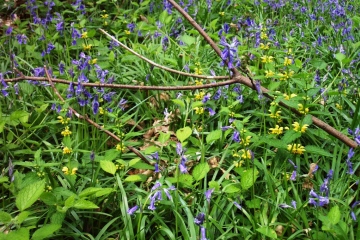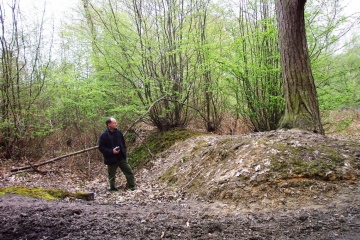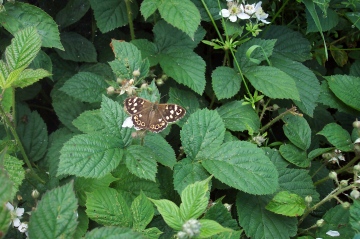Bluebells are now out in force in the local woods and have been joined by Yellow Archangel and Shirt Buttons; even a few early Plum Puddings. At Thrift Wood, Bicnacre, an area coppiced by the Blue House volunteers two winters ago is now a sea of Wood Anemones while at the farm itself Sea and Sticky Mouse-ears are coming into bloom on the counter walls and the first spear like shoots of Upright Chickweed are forcing their way through the soil while hundreds of diminutive Mouse Tail are crowding the dried mud on the banks of a neighbour's pond. The last two springs have been so dry that most of the chickweed wilted before it could flower and it is to be hoped that this week's rain (and that which is predicted to follow) will revive the fortunes of both this and other annual flowers such as Grass Vetchling, that have also suffered in the drought.
On the Writtle Park estate coppicing is continuing in some of the woods, not only Deerslade (mentioned elsewhere) but also Writtle Park Wood, one of a series of three coppices that were planted in the late 17th, early 18th centuries. Apparently they intend to carry out the work at the rate of around 2-4 hectares a year and as there are around 150 hectares that need coppicing it should last some while! It will only continue, of course, while demand remains high, wood being a commodity like any other, but as there are now around four billion people on this planet all understandably determined to jump aboard the same gravy train we have been riding for the past fifty years, there is a good chance of that happening! In the past the coppicing cycle on the estate was every 12-17 years but it would need to be longer than that for Hornbeam, which largely goes for firewood, but not for Sweet Chestnuts, the poles of which make excellent fence posts. The picture shows the medieval woodbank that separates Deerslade (Highwood, formerly Writtle) and Stoneymore (Ingatestone). It would have been even more impressive in its heyday but a hundred years or more of leaf-fall have filled the ditch beneath the bank.
It was a grotty week for insects but I did at last record the sixth and final common bumblebee, namely, the Common Carder Bee Bombus pascuorum in my garden. My first Small White of the year was another visitor, during a break in the cloud on 11th, and Speckled Woods were on the wing during a trip to Capel Manor, Herts on 14th.
A few more migrants struggled in during the week including Willow Warblers at Bradwell, Nightingale at Two Tree Island and Whimbrel at Blue House but a deep low pressure over southern Europe as well as here is preventing many birds from moving northwards. The BTO's migration blog shows a picture of fifty or so Swallows huddled dejectedly out of the rain beneath the eaves of a bird hide in the Pyrenees while Chris, my sponsored Cuckoo (one of five radio tagged by the BTO last spring), who spent much of the winter in the Congo, is still in northern Italy awaiting a change in the weather so that he can travel the final few hundfred miles back to Norfolk.





















